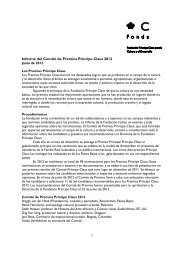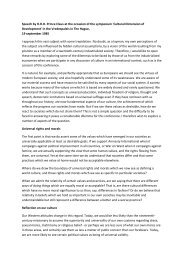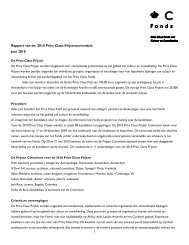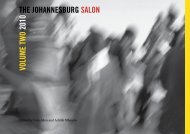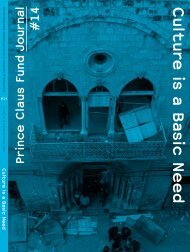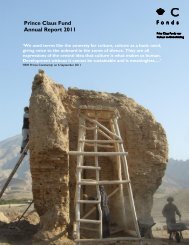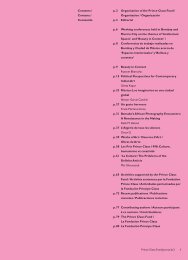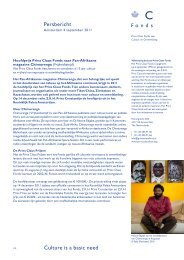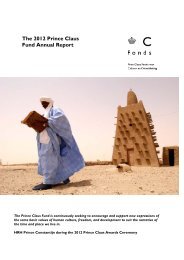30r364 boek.qxd:awards book 11 - Prince Claus Fund
30r364 boek.qxd:awards book 11 - Prince Claus Fund
30r364 boek.qxd:awards book 11 - Prince Claus Fund
Create successful ePaper yourself
Turn your PDF publications into a flip-book with our unique Google optimized e-Paper software.
The Desired Sense of Parityby Mark SealyEarly photography in the hands of the European colonial officer, American plantation owner,scientist, artist or would-be adventurer was employed to propagate an imagined constructionof the African subject. The resultant images emphasised the message that Africans were thechildhood of mankind: primitive, exotically simple, barbaric, uncivilised, in urgent need of beingbrought out of the dark, and ideal objects of study for those interested in how humanity seeminglyonce was. Along with this portrayal of being ‘primitive’, African subjects wherever they weresituated, be it on plantations across the Caribbean, throughout the Americas or caught incolonised territories in Africa, were predominantly rendered naturally suitable to a condition ofservitude. Africa was not just colonised physically – visually it became the subject of westernmyth and fantasy. Within Europe, Africa functioned as a dark rumour in which a myriad of fantasticstories could be told or imagined. The outcome of these myths and rumours was violent scrutiny,ultimate humiliation and totalitarian control. Within the European visual plane, photography didnot describe the ‘other’: it constructed it. Photography turned Africa into a static theatre thathid western excess. Through photography, the colonial master was able to construct a visualnarrative that enabled the colonial to see only what was required and believed in, rather thanwhat was real and what was being destroyed. The application of photography by Europeans inAfrica aided the political exercise of cultural negation and forced assimilation.When we look at James Iroha Uchechukwu’s photographs it’s important that we view thework in the context of Time and Distance. The 1991 exhibition titled ‘Africa Explores: 20th CenturyAfrican Art’, held in New York, hinted at the fact that photography was alive and doing wellthroughout the continent. Since then there has been a slow but sure recognition of indigenousAfrican photographers who are dedicated to producing images that configure the Africansubject in the now.Within Uchechukwu’s work there is a pressing sense of wanting to address the contemporary.His group studies of butchers, athletes, and soft-drink hawkers address the acute conditionof toil, aspiration, struggle and achievement. All the subjects framed present a common threadof pride and resilience. His photographs disrupt the very idea of a mythical African subject. Theybuild on the concept of a critical platform rather than simply images for display or contemp lation.They force an engagement beyond the aesthetic and open up dialogues relating to the keyquestion of authority and visual power: who’s looking at who and why. His work forms part of agrowing critical body of images being produced by indigenous African photographers both northand south of the Sahara. This indigenous critical voice within contemporary African photographyis its most exciting element. Festivals such as the ‘Rencontres africaines de la Photographie’in Mali are testament to this vibrancy. It’s becoming increasingly difficult to ignore the creativesurge of images being produced by African artists. There is a collective sense of visual reclaimingat work throughout Uchechukwu’s photographs, also evident in the work he produced whilstworking within the Depth of Field collective.This indigenous African discourse is swelling. It’s saturated with difference and demandsnew intellectual work from the viewer/reader. The terrain of interpretation across the historyof photography is a highly contested space and Uchechukwu’s photographs function like hotmolecules across the body politic of photographic institutions that regurgitate the same oldcanon and are fixated on displaying representations of the African subject that carry the grainof racism. The history of photography is marked by its anthropological leanings.1002008 <strong>Prince</strong> <strong>Claus</strong> Awards



